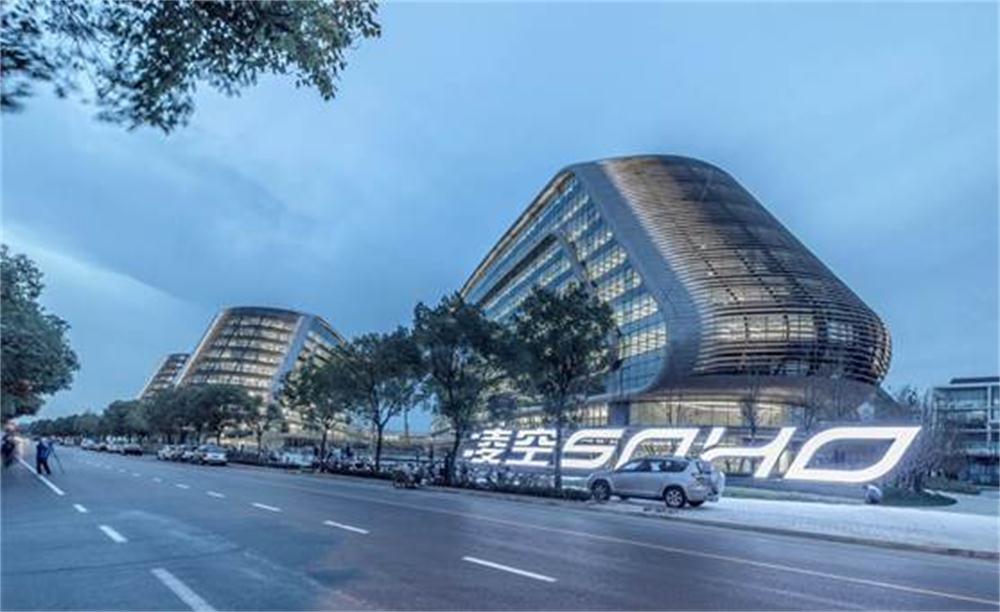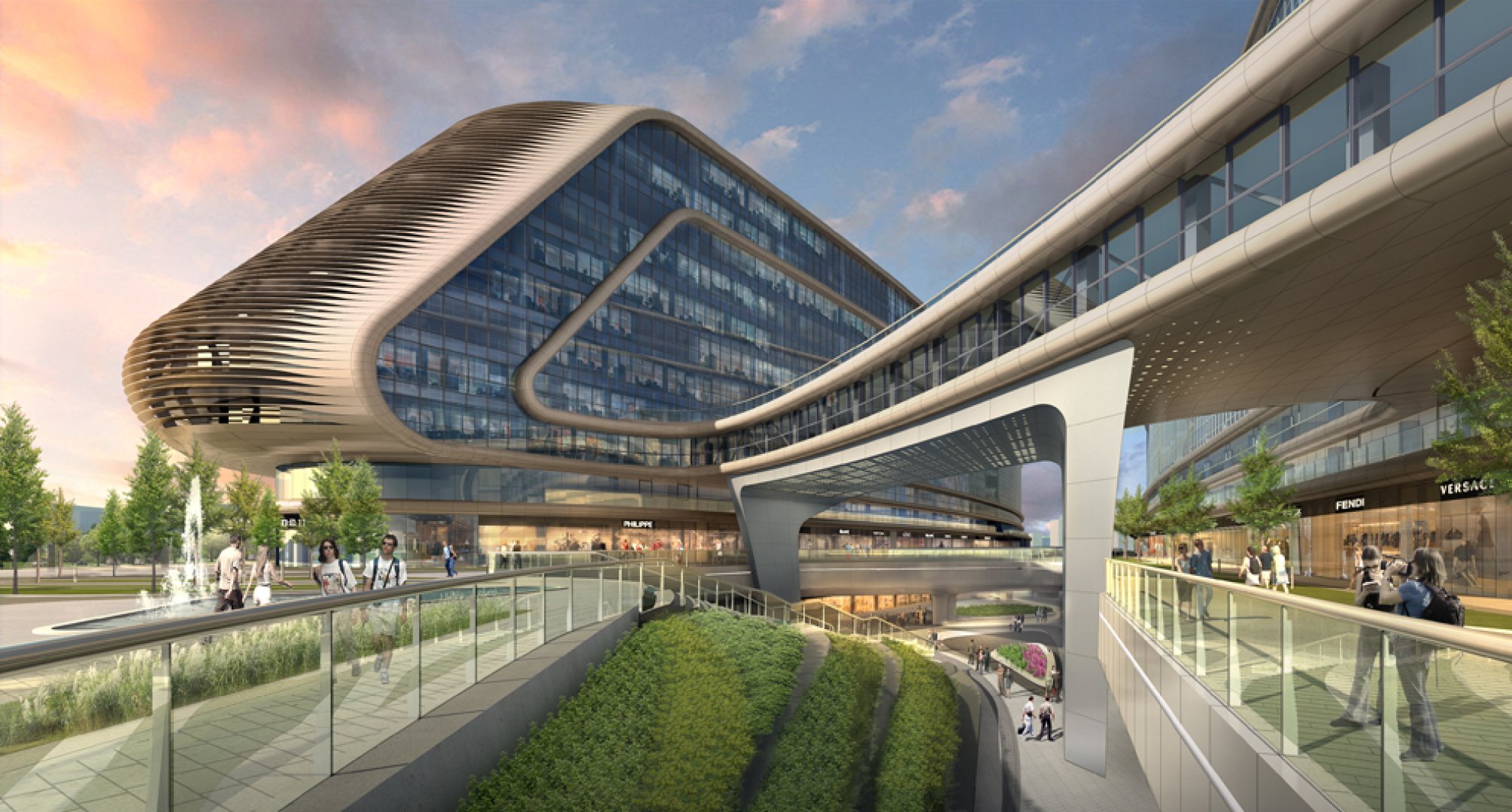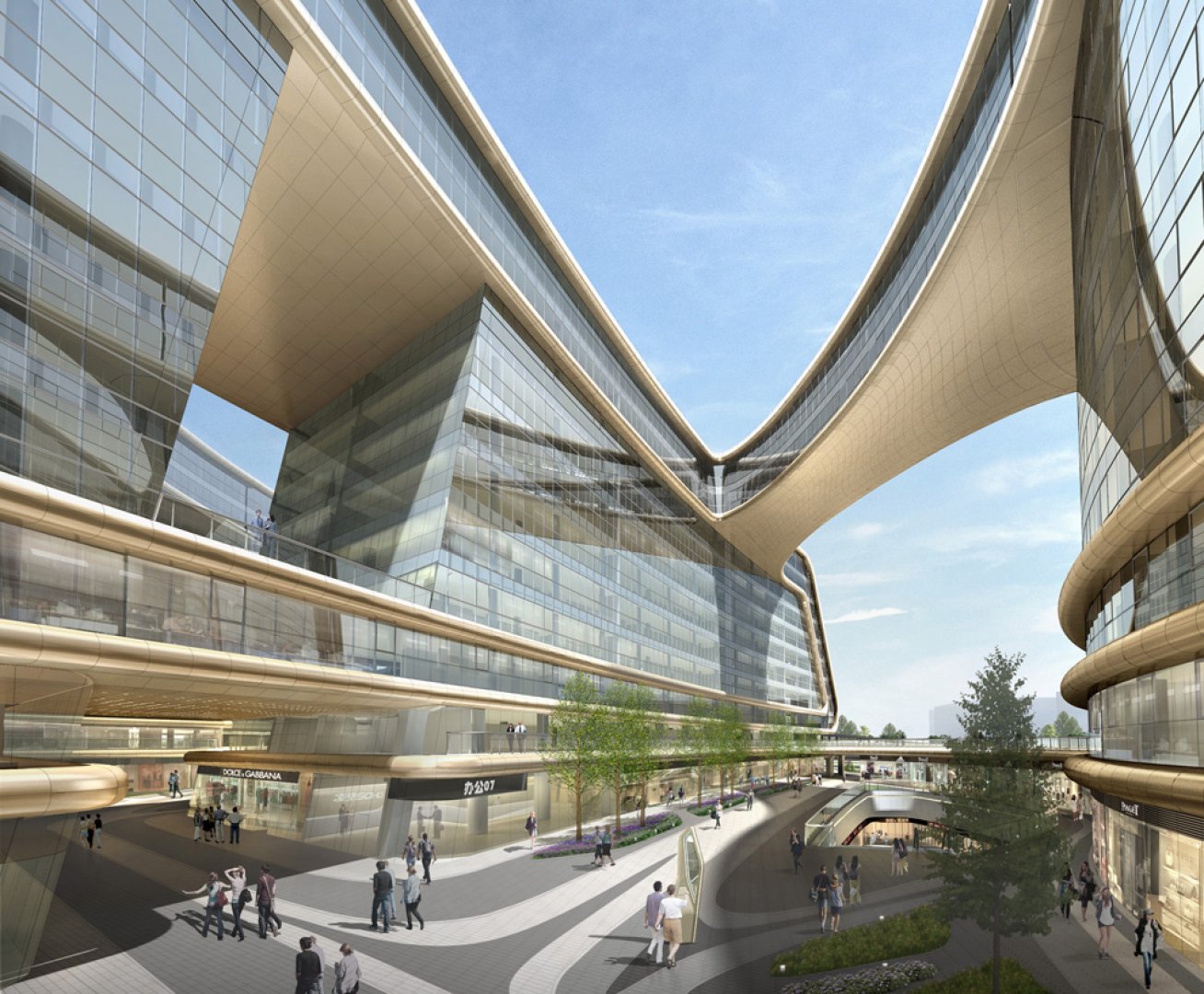Shanghai's newest landmark, Sky SOHO, debuted this week with a grand opening carnival celebration and light show attended by more than 10,000 spectators to witness the inauguration of the futuristic architecture.
Sky SOHO is Zaha Hadid's first work in Shanghai. Located on a lot of 86,000 sm and with a total GFA of 350,000 sm, Sky SOHO is comprised of 12 standalone buildings interlinked by 16 sky bridges. The buildings resemble four bullet trains about to take off.
Sky SOHO is the third in a trilogy of SOHO China developments designed by Zaha Hadid Architects, following Galaxy SOHO and Wangjing SOHO in Beijing.
Situated in the Shanghai Hongqiao Airport Economic Zone, Sky SOHO is adjacent to the Hongqiao transportation hub. The area is already home to the headquarters of over 800 companies, and has become established as an especially dense and active commercial zone in the Yangtze River Delta region. Boasting its spectacular design and advantageous location, Sky SOHO is Shanghai's new iconic landmark building.
Sky SOHO was designed to be a green, sustainable building with efficient energy use. So far, it has achieved LEED Gold precertification. To manage Shanghai's chronic air pollution and ensure high quality clean air indoors, Sky SOHO uses an advanced air purification system to effectively filter out over 90% of the atmospheric PM2.5, far exceeding the national standard.

Renderings courtesy Zaha Hadid Architects
Sky SOHO is also equipped with a pure-drinking water five-layer filtration system that meets the water standards for aerospace facilities. Filtered water will be provided to all office kitchens above the second floor level.
This past September, SOHO China announced the sale of 100,167 sm of the Sky SOHO to Ctrip Travel Network Technology for its future office space development. Ctrip's presence is expected to invigorate the business environment, which will in turn facilitate the Sky SOHO leasing.
SOHO China Chairman Pan Shiyi comments, "After four years of arduous work, we have finally been able to transform the architect's blue prints into a new landmark for Shanghai. We thank every construction party for their tremendous efforts. We have always been very positive in our outlook on the Shanghai market, and will continue to strive to bring more iconic architectural works to this dynamic and cosmopolitan city."
Related Stories
MFPRO+ New Projects | Oct 30, 2024
BIG’s One High Line finally reaches completion in New York City’s West Chelsea neighborhood
One High Line, a luxury residential project spanning a full city block in New York’s West Chelsea neighborhood, reached completion this summer following years of delays related to investor lawsuits.
Urban Planning | Oct 30, 2024
Bridging the gap: How early architect involvement can revolutionize a city’s capital improvement plans
Capital Improvement Plans (CIPs) typically span three to five years and outline future city projects and their costs. While they set the stage, the design and construction of these projects often extend beyond the CIP window, leading to a disconnect between the initial budget and evolving project scope. This can result in financial shortfalls, forcing cities to cut back on critical project features.
MFPRO+ New Projects | Oct 30, 2024
Luxury waterfront tower in Brooklyn features East River and Manhattan skyline views
Leasing recently began for The Dupont, a 41-story luxury rental property along the Brooklyn, N.Y., waterfront. Located within the 22-acre Greenpoint Landing, where it overlooks the newly constructed Newtown Barge Park, the high-rise features East River and Manhattan skyline views along with 20,000 sf of indoor and outdoor communal space.
Libraries | Oct 30, 2024
Reasons to reinvent the Midcentury academic library
DLR Group's Interior Design Leader Gretchen Holy, Assoc. IIDA, shares the idea that a designer's responsibility to embrace a library’s history, respect its past, and create an environment that will serve student populations for the next 100 years.
Resiliency | Oct 29, 2024
Climate change degrades buildings slowly but steadily
While natural disasters such as hurricanes and wildfires can destroy buildings in minutes, other factors exacerbated by climate change degrade buildings more slowly but still cause costly damage.
Office Buildings | Oct 29, 2024
Editorial call for Office Building project case studies
BD+C editors are looking to feature a roundup of office building projects for 2024, including office-to-residential conversions. Deadline for submission: December 6, 2024.
Healthcare Facilities | Oct 28, 2024
New surgical tower is largest addition to UNC Health campus in Chapel Hill
Construction on UNC Health’s North Carolina Surgical Hospital, the largest addition to the Chapel Hill campus since it was built in 1952, was recently completed. The seven-story, 375,000-sf structure houses 26 operating rooms, four of which are hybrid size to accommodate additional equipment and technology for newly developed procedures.
Multifamily Housing | Oct 28, 2024
A case for mid-rise: How multifamily housing can reshape our cities
Often referred to as “five-over-ones,” the mid-rise apartment type is typically comprised of five stories of apartments on top of a concrete “podium” of ground-floor retail. The main criticism of the “five-over-one” is that they are often too predictable.
Sports and Recreational Facilities | Oct 24, 2024
Stadium renovation plans unveiled for Boston’s National Women’s Soccer League
A city-owned 75-year-old stadium in Boston’s historic Franklin Park will be renovated for a new National Women’s Soccer League team. The park, designed by Fredrick Law Olmsted in the 1880s, is the home of White Stadium, which was built in 1949 and has since fallen into disrepair.
Laboratories | Oct 23, 2024
From sterile to stimulating: The rise of community-centric life sciences campuses
To distinguish their life sciences campuses, developers are partnering with architectural and design firms to reimagine life sciences facilities as vibrant, welcoming destinations. By emphasizing four key elements—wellness, collaboration, biophilic design, and community integration—they are setting their properties apart.




















